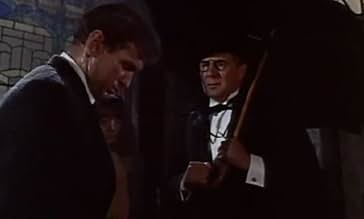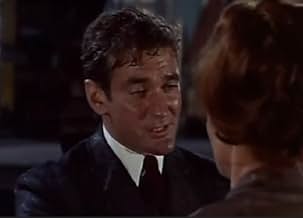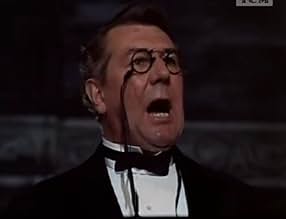Aggiungi una trama nella tua linguaThe misadventures of a young idealist man in Dublin, Ireland in the early twentieth century.The misadventures of a young idealist man in Dublin, Ireland in the early twentieth century.The misadventures of a young idealist man in Dublin, Ireland in the early twentieth century.
- Regia
- Sceneggiatura
- Star
- Nominato ai 2 BAFTA Award
- 1 vittoria e 3 candidature totali
- Mick Mullen
- (as Phillip O'Flynn)
- Bessie Ballynoy
- (as Pauline Delany)
Recensioni in evidenza
The story was originally to have been made by John Ford, which isn't surprising due to his love of all things Irish in his movies. It follows O'Casey (Rod Taylor) from working as a day laborer to his becoming a hated dramatist, as you see one of his plays being booed and attacked by many.
I gave this movie a 6 because it tries hard and offers some nice moments. But it was a hard sell to me because the film made O'Casey seem like a bit of a jerk and I really didn't have all that much interest in him and his life. I am not sure if it's because O'Casey was a jerk or just because of the screen play. I just found myself not caring much about him or his life.
Dublin in the 1920s, with all the period feel and detail John Ford and Jack Cardiff could muster, beautifully photographed in Color and on location by Ted Scaife.
A splendid cast brings the days of O'Casey and the Troubles to vibrant and bitter life. Taylor's best work in many ways, though he did so many good movies and gave so many good pefs in his heyday, it's hard to pick just one.
Maggie Smith is marvelous as Cassidy's lost love: "I'm a small simple girl. I need a small simple life, not your terrible dreams and your anger." Smart girl, but two hearts are broken as Cassidy boards the boat for parts unknown.
Julie Christie's a revelation as Daisy, one of three stunningly good perfs she delivered in her Oscar winning golden year. Michael Redgrave is just right as Yeats; and Flora Robson gets a late career lift as Cassidy's Ma.
The entire production takes the viewer back in time to the turbulent setting of O'Casey's youth, in an exceptionally good yet unfairly overlooked film.
I believe John Ford was responsible for a few scenes in the film, including the scene where Rod Taylor (Sean O'Casey/Cassidy) enters the room where his mother (Dame Flora Robson) lies dead. This sequence is extraordinary--described and narrated by Taylor's monologue and actions. This does not stand up to the quality of the rest of the film, which is below average. Now Cardiff is a good cinematographer. He has to deal with a great cast assembled by Ford, who individually perform very well, and are captured well by Cardiff's visual eye but lack the vision of a great director to string the pearls together into a great necklace. The film's ending is amusing--a poor man turned rich man handing a crown to a vagrant who appreciates the worth of the money. What had the ending to do with what preceded it? If anything, the final scene is ambiguous and one begins to wonder whether the director was making a hero of Sean O'Casey or was he chastising him as are the film's oblique comments on Yeats living in sheltered house, policed by the British. The poor man turned into a rich and famous playwright is presented to us in fits and starts. The film did have a good intention but it lapses into mediocrity. Only two characters develop well--the mother (Robson) and Nora (Maggie Smith).
Julie Christie is mesmerising in any film but her character is never developed. Maggie Smith has charmed audiences over the years but this film is definitely one of her finest. Dames Robson and Evans are daunting thespians. Add to them Michael Redgrave. All great actors--including Aussie Rod Taylor. The film does not end with a bang but with a whimper.
Lo sapevi?
- QuizIn an interview, director Jack Cardiff said that only four minutes and five seconds of the footage shot by John Ford ended up in the finished movie. The riot scene was cited by critics as the obvious work of Ford, yet it was completely done by Cardiff who admitted that he found inspiration from Battleship Potemkin (1925).
- BlooperThe story is set around 1910. One hour into the story a horse and carriage pass by. A 1960s-era car is seen turning at an intersection where it just came from.
- Citazioni
W.B. Yeats: You're young Cassidy, and that makes your passion effortless and artless. Think towards the day when you are old and the passion is painful and remorseless. What you have now has given you pity. What you must one day find will give you compassion. Age, the winter days, make the chill of the frost as compelling as the heat of the sun. Lovers look towards the time of day when the sun goes down. But give a thought to the time, when as an old man, you'll be surprised to see the sun come up. The warmth of your girl's body inspires you now, Cassidy. There will be a time when you must be inspired by the Artic waste. Prepare for that.
- Curiosità sui creditiBilled as "A John Ford Film", although Jack Cardiff is credited as sole director.
- ConnessioniFeatured in Sean O'Casey: The Spirit of Ireland (1965)
I più visti
- How long is Young Cassidy?Powered by Alexa
Dettagli
- Tempo di esecuzione1 ora 50 minuti
- Mix di suoni
- Proporzioni
- 1.66 : 1
Contribuisci a questa pagina































